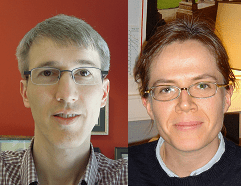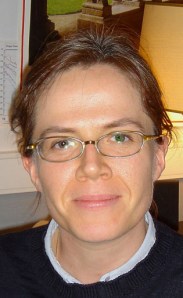The gravitational-wave observatory Advanced LIGO is now in its commissioning stage and preparing for its first scientific runs in early 2015. It will be soon followed by the Advanced Virgo detector. Being reasonably optimistic, one can expect the first detections to occur by 2018. The most likely sources to be observed are coalescences of two compact objects. As both detection and
parameter estimation rely on matched filtering techniques, several programs to compute accurate waveform models using various approximation techniques are being pursued. Notably, the post-Newtonian perturbative approach, where all quantities of interest are expanded in powers of Continue reading
Tag Archives: gravitational waves
Improved constraint on the primordial gravitational-wave density

Sophie Henrot-Versillé and Florent Robinet are research associates at the Laboratoire de l’Accélérateur Linéaire d’Orsay
Many cosmological models predict the existence of a stochastic Gravitational-Wave (GW) background produced just after the universe was born. As gravitational waves do not interact with matter, their detection would give us a unique and pristine probe to study the very first instants of the Universe: when it was 50 orders of magnitude younger than its age at the epoch of the photon decoupling. Such a detection would be as important as the discovery of the Cosmological Microwave Background (CMB). CMB studies tell us what the universe looked like when it became optically thin (~300,000 years after the Big Bang). They help us to establish the standard ΛCDM model of cosmology and to understand the important role of inflation. Continue reading
Even a tiny cosmological constant casts a long shadow

Aruna Kesavan is a graduate student at the Pennsylvania State University
How safe is it to ignore the cosmological constant in the study of isolated systems and gravitational waves?
Analysis of isolated systems, such as stars, black holes and compact binaries, has dominated gravitational science, spanning diverse areas that include geometric analysis, computational relativity, gravitational waves, relativistic astrophysics and quantum black-holes. For example, over the past four decades, powerful positive energy theorems were proved, a theory of gravitational radiation in exact general relativity was developed, computational simulations were carried out to extract energy-momentum emitted during binary mergers, and evaporation of black holes was analyzed using appropriate Hilbert spaces of asymptotic states.
These advances are based on the Bondi-Penrose framework for zero cosmological constant . But by now observations have Continue reading
Video: Hunting for gravitational waves using pulsars

Louise Mayor is features editor of Physics World
As features editor of Physics World magazine, my search for stories to share with our readers takes me far and wide – from nuclear reactors to the quietest lab in the world. But sometimes I need look no further than the very office in which I work. That’s because I share my workplace with the staff behind nearly 70 journals published by IOP Publishing. So it was that one lunchtime earlier this year, I got chatting to Adam Day, publisher of Classical and Quantum Gravity (CQG).
Day began telling me about a method of detecting gravitational waves I’d not heard of before, and in no time at all I was hooked. First proposed in the 1970s, the method involves Continue reading
Achieving resonance in the Advanced LIGO gravitational-wave interferometer

Alexa Staley is a PhD candidate at Columbia University in the City of New York, and has been working as a graduate student at the LIGO Hanford Observatory in Richland, WA.
The next generation gravitational wave interferometers, known as Advanced LIGO, located in Hanford, WA and Livingston, LA have been installed and are in the process of achieving a sensitivity required for the first direct detection of a gravitational wave. The goal of their design is to measure a gravitational strain as small as 4×10–24/√Hz, requiring a length resolution of approximately 10–19 rms within a 100 Hz bandwidth. This high sensitivity demands multiple optical cavities to enhance the response Continue reading
New focus issue: Advanced interferometric gravitational wave detectors

Peter Shawhan is an Associate Professor of Physics at the University of Maryland, USA. His primary research area is in the analysis of data from gravitational wave detectors and connections with astrophysical events.
Marie-Anne Bizouard is a research fellow at CNRS, Laboratoire de l’Accélérateur Linéaire, Orsay, France. She is an experimental physicist working on gravitational wave searches with ground based interferometric detectors.
The quest to detect gravitational waves directly has seen great advances over the past five decades, with the earlier resonant “bar” detectors being surpassed in sensitivity by large laser interferometers in the last decade. The first generation of interferometric detectors proved the viability of the approach, progressively improving sensing and control techniques and running up against the fundamental limitations of their designs. Along the way, many searches for gravitational wave signals were carried out and published, but none achieved the milestone of detecting a clear gravitational-wave signal.
All of that is about to change. The lessons learned from the first full-scale interferometric detectors fed into the design of advanced detectors which are now being constructed and commissioned and will soon begin collecting data. Higher laser power, Continue reading
Memory at a distance

The author, overshadowed by nature in the Muir Woods on the California coast.
Jeff Winicour is a Professor of Physics and Astronomy at the University of Pittsburgh
Can the supertranslation symmetry of radiating spacetimes affect angular momentum loss?
That was the question on my mind when I went to a workshop at Berkeley, California last winter. I knew that the supertranslations were a global aspect of the gravitational memory effect, which produces a net displacement between particles after passage of a gravitational wave. What I didn’t know, and learned from David Garfinkle at Berkeley, was that there was an electromagnetic analog of radiation memory, which produces a momentum kick on test charges after passage of a wave. Surprisingly, this result has apparently gone unnoticed in Continue reading
Noisy surface charges on gravitational wave detector optics

Paul Campsie completed his Ph.D. in the Institute for Gravitational Research at the University of Glasgow. He now works as a Product & Test Engineer for Freescale Semiconductor.
A direct measurement of the fluctuating force noise created by surface charge on dielectrics
It has been known that future interferometric gravitational wave detectors could have their low frequency sensitivity limited by excess surface charges on the detector optics. Though it is suspected that the limiting effects of this noise source have been observed in initial detectors, this was never directly verified because there was no measurement of the charge on the optic.
In our recent CQG article we present a direct measurement of the fluctuating force noise created by excess surface charges (charging noise) on a dielectric. This measurement is Continue reading
Why are complete compact-binary-coalescence waveforms so important for compact-object astrophysics?

Marie-Anne Bizouard is a research fellow at CNRS, Laboratoire de l’Accélérateur Linéaire, Orsay, France.
She is an experimental physicist working on gravitational wave searches with ground based interferometric detectors.
The numerical relativity breakthrough in 2005 has provided waveforms of the gravitational wave signal emitted by a compact binary sources that describe the coalescence, the merger of the two compact objects and the ring-down of the newborn object. These waveforms are now more and more often used in gravitational wave searches carried out with interferometric detectors (LIGO, Virgo, GEO and eventually KAGRA), instead of analytical waveforms from Post Newtonian expansion that Continue reading


You must be logged in to post a comment.